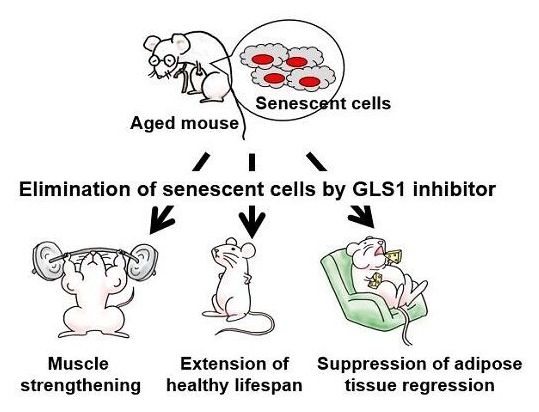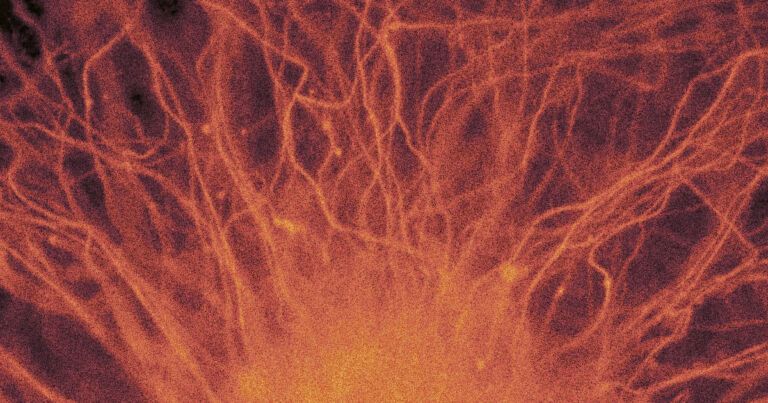Technique for trapped ions could lead to more reliable quantum computers.



The Federal Aviation Administration has released new and looser rules for flying drones over highly populated areas and at night, effectively laying a welcome mat for future aerial deliveries of takeout food, Amazon packages, prescription drugs — you name it.
Why it matters: While the prospect of Jetsons-style convenience with less street gridlock is tantalizing, there are still plenty of logistical hurdles, and it will take some time for cities to figure out how to manage low-altitude air traffic as routinely as they do today’s road traffic.
Driving the news: FAA rules — handed down late last month — will require drones flying over cities to use remote identification technology, so people on the ground can tell what they’re doing and who owns them.

A team of researchers affiliated with a host of institutions across Japan has found that inhibiting kidney-type glutaminase-dependent glutaminolysis in mice can lead to elimination of senescent cells. In their paper published in the journal Science, the group describes using RNA interference to look for enzymes that are required for senescent cell survival and subsequently inducing them to die. Christopher Pan and Jason Locasale, with the Duke University School of Medicine, have published a Perspectives piece in the same journal issue outlining research into glutamine and the role it played in the work done by the team in this new effort.
Cells are described as senescent when they lose the ability to divide. Prior research has found that cells can reach senescence due to exposure to stress, which can include mitochondrial, replicative or oxidative stress. In all cases, the cells live and continue to function, but can no longer divide. Prior research has found evidence suggesting that senescent cells play a role in the development of some aging-related diseases such as arteriosclerosis and muscle degeneration. For that reason, scientists have been looking for ways to eliminate them. In this new effort, the researchers have found a way to rid test mice of senescent cells by removing a pathway necessary for their continued survival.
The work involved a screening effort using RNA interference to look for enzymes that senescent cells need to survive. This led them to look closer at glutamine metabolism, specifically glutaminase 1. Testing showed it to be critical to survival for senescent cells. The team then inhibited the glutaminase 1 pathway in test mice. After allowing time for the changes to take effect, the researchers found that inhibiting the pathway led to the deaths of senescent cells. In the longer term, they found that it also reduced age-related organ problems and also health issues related to obesity.

It’s good that they’re finally looking at the science.
The New York Times is now noting that “once most adults are immune — following natural infection or vaccination” the virus will enter its endemic phase and corona “will be no more of a threat than the common cold, according to a study published in the journal Science on Tuesday.”
Once immunity is widespread in adults, the virus rampaging across the world will come to resemble the common cold, scientists predict.
This concept is, of course, entirely different from the earlier, reviled concept of “herd immunity,” which was so successfully dismissed by the New York Times and a great many other publications of record last spring.
For the for story, check out the January 12th, 2021 New York Times post, “The Future of the Coronavirus? An Annoying Childhood Infection.”

To date, paralysis resulting from spinal cord damage has been irreparable. With a new therapeutic approach, scientists from the Department for Cell Physiology at Ruhr-Universität Bochum (RUB) headed by Professor Dietmar Fischer have succeeded for the first time in getting paralyzed mice to walk again. The keys to this are the protein hyper-interleukin-6, which stimulates nerve cells to regenerate, and the way how it is supplied to the animals. The researchers published their report in the journal Nature Communications from 15 January 2021.
Spinal cord injuries caused by sports or traffic accidents often result in permanent disabilities such as paraplegia. This is caused by damage to nerve fibers, so-called axons, which carry information from the brain to the muscles and back from the skin and muscles. If these fibers are damaged due to injury or illness, this communication is interrupted. Since severed axons in the spinal cord can’t grow back, the patients suffer from paralysis and numbness for life. To date, there are still no treatment options that could restore the lost functions in affected patients.

Scientists have developed a first-of-its-kind human stem cell that seems to be capable of repairing and healing damage anywhere in the body.
These so-called “smart” stem cells start off as human fat cells. But after being reprogrammed with cancer drugs that stripped the cells of their identity, they turned back into multipotent stem cells that were able to adapt to their surroundings in a mouse model, according to research published Wednesday in the journal Science Advances.”
While these findings are very exciting, I will keep a lid on my excitement until we get this through to patients, Chandrakanthan said in the press release.
Among popular public thinkers advocating for the simulation hypothesis is Elon Musk who stated: if you assume any rate of improvement at all, games will eventually be indistinguishable from reality “before concluding ” that its most likely we’re in a simulation.
Elon Musk is known in the philosophical community to make “outrageous” claims, whether its about the advent of digital superintelligence, or in this case, according to some skeptics of the simulation hypothesis, Elon Musk exaggerates the probability that we might be living in a simulation.
Another high-profile proponent to the hypothesis is famous astrophysicist Neil Degrasse Tyson, who said in an NBC news interview that the hypothesis is correct giving better than 50–50 odds and adding: I wish I could summon a strong argument against it, but I can find none.
In a review of the literature on simulated realities, philosopher Nick Bostrom argues that although it is difficult to prove that we are living in a simulation, “It is nevertheless generally considered acceptable philosophy to question the reality of our own existence.
A typical member of an advanced civilization would have a high probability of being among the simulated minds rather than among the original biological ones. Therefore, if we are typical, we should consider that we might be living in a simulation. Thus, the possibility that we are living in a simulation is greater than we might have supposed.
Some hypotheses hold that if it is possible to simulate reality, then it is also possible to leave behind copies of everyone within these simulations. It has further been suggested that these simulated people may be conscious or sentient, although this idea belongs more in the realm of philosophy rather than scientific inquiry.

“By contemplating the full spectrum of scenarios of the coming technological singularities, many can place their bets in favor of the Cybernetic Singularity which is the surest path to cybernetic immortality and engineered godhood as opposed to the AI Singularity when Homo sapiens is hastily retired as a senescent parent. This meta-system transition from the networked Global Brain to the Gaian Mind is all about evolution of our own individual minds; it’s all about our own Self-Transcendence.”-Alex M. Vikoulov, The Cybernetic Singularity: The Syntellect Emergence #CyberneticSingularity #SyntellectEmergence #CyberneticTheoryofMind #AlexMVikoulov #consciousness #phenomenology #evolution #cybernetics #SyntellectHypothesis #PhilosophyofMind #QuantumTheory #PhysicsofTime #PressRelease #NewBookRelease #AmazonKindle #AlexVikoulov #EcstadelicMediaGroup
Ecstadelic Media Group releases a new non-fiction book The Cybernetic Singularity: The Syntellect Emergence, The Cybernetic Theory of Mind series by Alex M. Vikoulov as a Kindle eBook (Press Release, San Francisco, CA, USA, January 102021 08.00 PM PST)
Circa 2019 😃
The La Moto Volante from French company Lazareth demonstrated its first stable hover. NASA’s helicopter that will fly on Mars has passed its flight tests. And Boston Dynamics’ upgraded Handle robot is a champ at warehouse Tetris.
CNET playlists: https://www.youtube.com/user/CNETTV/playlists.
Download the new CNET app: https://cnet.app.link/GWuXq8ExzG
Like us on Facebook: https://www.facebook.com/cnet.
Follow us on Twitter: https://www.twitter.com/cnet.
Follow us on Instagram: http://bit.ly/2icCYYm
The consumer electronics show was virtual this year, and the WIRED Gear crew watched all the Zooms to bring you this list of nearly 80 products, trends, musings, and photos.